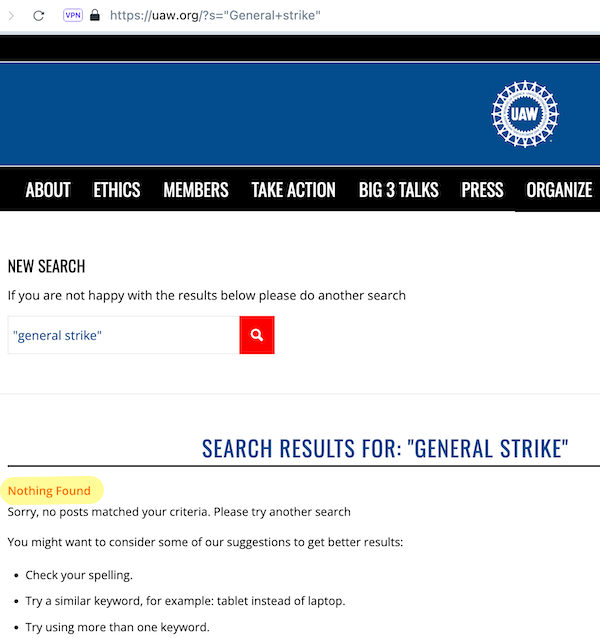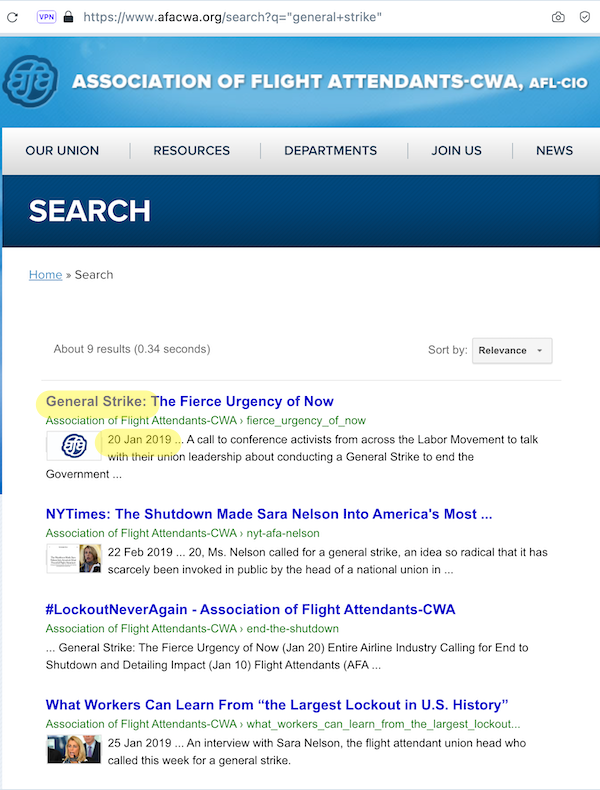By Lambert Strether of Corrente.
“Two are better than one, because they have a good return for their labor.” –Ecclesiastes 4:9
“If you’ve got ’em by the balls, the heart and mind soon follow.” –Author Unknown
Labor Day 2024 seems like an appropriate date to look forward to May Day 2028, the date for which UAW President Shawn Fain, fresh from his “stand-up strike” triumph with the Big Three automakers, has called for a General Strike(1). It’s nice to have time to prepare!
In doing the research for this post, I came to understand how little I know about the labor movement, so I hope that readers will bear with me, and union mavens who know more will correct me. It’s a sad commentary that the only mainstream publication with a regular labor beat is Teen Vogue, where Kim Kelly writes the “No Class” column. It would be a fine thing if every newspaper had a Kim Kelly (or a Mike Elk). It’s also frustrating that much of the reporting on labor — at least that which gets amplified — comes from niche publications on the unmasked, brunch-focused, Democrat-servicing, NGO-aligned putative left. All this combines to make me feel that we really don’t know what’s going on out there in the locals, let alone the workplace itself, which does allow one at least to project a certain sense of optimism. Just possibly Shawn Fain knows more than I do, or any of them do.
In this post, I will first give some background on the general strike (definition; history). Then I will quote Shawn Fain’s views (2023 and 2024). Next, I’ll present friendly amendments to and critiques of Fain’s views. Finally, I will play the armchair strategist snd present my own critique (hoping I have made clear that I have no particular qualifications to do this).
The General Strike: Background
Here is the definition of “General Strike,” from the Teamsters site:
A strike by all or most organized workers in a community or nation.
Kim Kelly gives a somewhat more wide-angled definition:
A general strike is a labor action in which a significant amount of workers from a number of different industries who comprise a majority of the total labor force within a particular city, region, or country come together to take collective action. Organized strikes are generally called by labor union leadership, but they impact more than just those in the union.
(I like Kelly’s definition better — sorry, Teamsters! — because her jurisdiction heirarchy is richer, and because she emphasizes the role of the community.
From the DSA, “Looking Back to Look Forward to 2028,” here is a potted history of general strikes in the Great Depression, which were critical to the formation of the union movement as we know it today
Ten years later when the Great Depression broke out in 1929, conditions appeared to have lurched back to the nineteenth century; the truth was more complicated. Important quantitative shifts had prepared the ground for a qualitative breakthrough. First, radicals led thousands of workplace organizing drives during the early Thirties. 1934 marked a turning point with , drawing in more than 1.5 million workers. Many of them joined the Communist and Socialist Parties, creating the largest left parties in U.S. history. Second, , touching off a war within the AFL and the emergence of the Congress of Industrial Organizations. Some union leaders understood that if they didn’t lead the rebellion, they might be left behind. Others genuinely supported it and threw their (relatively) well-resourced unions behind it. Third, although Roosevelt’s New Deal had only a small impact on macroeconomic activity, his administration created the foundation for the modern interventionist federal state, both in terms of economic investment—which really only took root as war production cranked up—and increasingly significant regulatory power. If Wilson’s National War Labor Board was a test balloon, .
It’s impossible to reduce what came next to the “right conditions.” Strategic, tactical, and political debates raged throughout these years, but .
Now let’s turn to Shawn Fain and the present day.
UAW President Fain’s Calls for a General Strike
I came into this thinking that Fain had delivered a single address, which then got amplified, but in fact he first broached the idea in his report to the UAW membership after winning the UAW contract with the Big Three. He’s followed through several times thereafter. Here are several examples:
October 29, 2023. Fain’s report to the membership (CC disabled, sadly, so no YouTube transcript):
UAW’s Facebook page (!) (quoted but not linked by Common Dreams) contains the key passages from our standpoint:
“The Stand Up Strike will go down in history as an inflection point for our union, and for our movement.
We went to each of the Big 3 and proposed an expiration date of April 30, 2028. We did this for several reasons.
First, this allows us to strike on May Day, or International Workers’ Day.
If we are going to truly take on the billionaire class and rebuild the economy so that it starts to work for the benefit of the many and not the few, then it’s important that we not only strike, but that we strike together.
…This contract is about more than just economic gains for autoworkers. It’s a turning point in the class war that has been raging in this country for the past forty years.
Why contract alignment? Kim Kelly explains:
(S)ympathy strikes (in which workers join a strike in solidarity with strikers at another workplace) are, in most cases, illegal in the US. Due to the 1947 Taft-Hartley Act, which was passed in the wake of the women-led 1946 Oakland general strike, general strikes are effectively illegal too. This trampling of the right of workers to show solidarity has been a source of frustration for decades, but has also prompted union members and leaders to get creative when necessary.
So if, as Fain has suggested, a number of separate unions happen to set their contracts to expire at the same time, and happen to go out on strike as a result, there are no laws being broken. That’s just good timing. And then, for example, if thousands of other workers, union and nonunion alike, who are sympathetic to the cause, all happened to fall ill at the same time and had to take off work during the general strike… well, that’s just plumb bad luck.
January 22, 2024. The Guardian:
Speaking to union members at the UAW national political conference in Washington DC, Fain said it was time for union members to come together.
“We have to pay for our sins of the past. Back in 1980 when Reagan at the time fired PATCO workers (here), everybody in this country should have stood up and walked the hell out,” Fain said. “We missed the opportunity then, but we’re not going to miss it in 2028. That’s the plan. .”
He reaffirmed ambitious plans to organize a general strike for 1 May 2028, coinciding with International Solidarity Day or May Day.
April 30, 2024. Shawn Fain, In These Times, “May Day 2028 Could Transform the Labor Movement—and the World“l
We wanted to ensure our contracts expired at midnight on April 30, 2028, not as a symbolic gesture, but as a rallying cry. We’ve asked other unions to join us in setting their contract expiration dates to May Day 2028 in hopes the labor movement can collectively aspire to building the power needed to change the world.
There’s been talk about a ”general strike” for as long as I’ve been alive. But that’s all it has been: talk.
If we are serious about building enough collective power to win universal healthcare and the right to retire with dignity, then we need to spend the next four years getting prepared.
A general strike isn’t going to happen on a whim. It’s not going to happen over social media. .
As working people, we must come together. We can no longer allow corporations, politicians and borders to divide us.
And:
We are fully preparing to strike on May Day 2028.
The first is that, to reshape the economy into one that works for the benefit of everyone — not just the wealthy — we need to reclaim our country’s history of militant trade unions that united workers across race, gender and nationality.
Critiques of Fain
(1) How serious is the UAW really? From Hamilton Nolan (2024), at the Labor Notes Conference in Chicago:
A number of people in the room told Brooks that it would be helpful if their union leaders could have a set contact point at UAW who would help them coordinate, and he appeared to take that in in good faith, but the UAW doesn’t seem to have any sort of big ongoing staffed effort to coordinate this thing right now. They are in the “inspire others to do this thing which is a collective effort” phase, which is fine.
If such a contact point exists on the UAW website, I can’t find it. Indeed:

There’s nothing on the UAW site about a general strike at all, now or in the past. So when is that “staffed effort” going to start? From In These Times:
We must see some tangible coordination of action across the U.S. labor movement. It is great when one union wins a contract, or organizes an important new company, but those isolated events will not be enough to take on the combined power of trillion-dollar multinational corporations and their political allies. Not even when they involve tens or hundreds of thousands of workers. Big unions, the ones with the most resources, along with whatever non-union groups want to help them, must be able to sit down and plan and carry out big national campaigns together if we want to have any chance at winning the class war.
(2) “Show some muscle” but to what end? It is true that Fain (above) mentions “universal healthcare and the right to retire with dignity,” but concrete material benefits don’t seem to be in the forefront of his thinking (which might not be a bad thing; see the Conclusion.) I note in passing that “universal health care” is not single payer, let alone a National Health Service; in fact, I seem to recall some ObamaCare advocates claiming, back in the day, that a combination of private health insurance plus ObamaCare filling in the gaps was, operationally, “universal health care,” so problem solved! One sardonic comment from trainer Jane McAlevey:
In the old days, the thing that really turned me off from the organized US left was that every time I would show up at a Left conference, I’d be immediately swarmed by white guys hawking papers in four-point font with their political line. And that’s not going to build a class-based, effective movement that’s tackling race and gender.
Medicare for All being one such hawked thing, sadly. (Although I have to say that the idea of a class-based movement that doesn’t “tackle” class seems odd to me.)
(3) Contract aligment may be the best tactic, but is it the only one? Hamilton Nolan once more, from the same conference:
The man from SEIU made the point that a general strike doesn’t need every participant to have exactly the same contract expiration date. For a May Day 2028 strike, for example, people working under any contract that expired before that date could just keep their contract bargaining going until May Day. Also, anyone who had unionized but was still negotiating a first contract could grab onto May Day as a self-imposed deadline and participate in the strike. So rather than thinking about only unions that could get that exact expiration date as possible participants, think about all the unions whose contracts expire in a six month window preceding that date, along with all the unions negotiating first contracts, along with all the unions willing to say “fuck it” and strike illegally. That is a much, much larger pool.
(4) What about opposition from the national unions? The labor movement can rightly be said to be fractious. From Socialist Call:
One is the difficulty of getting many unions on board, because of the fragmentation of the labor movement, the siloes and leaders’ egos. The president of one union doesn’t see himself as needing a leader from a different union. The established leaders don’t know Fain well and they have reasons to distrust him — his origins in dissent, his radical rhetoric, and even his widely publicized winning strike against the Big 3 automakers last fall, an achievement others can’t point to. In 1997 the Teamsters’ strike at UPS was a resounding national success but it did not lead to other unions’ doing likewise.
In our Balkanized system it’s hard for successes to spread from union to union.
But:
A possible exception is the idea of reform from below, as reformers in other unions (Food and Commercial Workers, Massachusetts Teachers, Chicago Teachers, Professional and Technical Engineers, Machinists, Theatrical Stage Employees) have taken heart from the example of Teamsters for a Democratic Union and now Unite All Workers for Democracy, the movement in the Auto Workers, and begun their own caucuses. That direct learning from each other is part of what Labor Notes promotes. But with reformers decidedly not in control of many unions, the power of a good example of how to lead is… less powerful.
Leading me to—
(5) How about support from the locals?. From HuffPo:
Eight councils affiliated with the AFL-CIO labor federation have endorsed the (general strike) concept so far, said Connor Lewis, a union member, writer and president of the Seven Mountains Central Labor Council in central Pennsylvania. The councils span six states; the most recent to sign on was the council for Louisville, Kentucky, where Ford workers went on strike last year.
(6) Who organizes community mutual aid networks? From Kim Kelly, “Everything You Need to Know About General Strikes“:
Organizers stress the importance of first building mutual aid networks and strong community systems to care for people in the event of a mass labor action like a general strike, before asking people to hit the streets. It’s hard enough to go out on a planned strike during union contract negotiations…. In those cases, workers at least have the support of their union, and, hopefully, a strike fund to help cover bills.
(7) Isn’t the general strike a “one-shot” strategy? From Kim Kelly, “The UAW Strike May Have Finally Set Us Up for a General Strike“:
To be brutally honest, though, we’ll probably only get one shot at this before the government magics up a new set of laws to make it even more difficult to try.
I would imagine lawfare against the union leadership is also a possibility, especially under a Harris administration.
Armchair Strategy
Here is Fain’s favorite bible quote in full (the first verse being the epigraph). Ecclesiastes 4:9-12:
9 Two are better than one, because they have a good reward for their toil. 10 For if they fall, one will lift up his fellow. But woe to him who is alone when he falls and has not another to lift him up! 11 Again, if two lie together, they keep warm, but how can one keep warm alone? 12 And though a man might prevail against one who is alone, two will withstand him—
Let’s take that “threefold cord” as an omen or a heuristic, and ask ourselves which other two major, national unions besides the UAW would be sufficient for a general strike.(2),(3) If we consider the second epigraph (“If you’ve got ’em by the balls….”) then the question becomes which unions control which chokepoints. The answer can only be those unions that control essential parts of the supply chain. Kim Moody (not Kelly) urges:
Even as capital in the United States was consolidating in industry after industry, the ties that bind the production of goods and services together, whether locally or across space, were tightening in new and important ways…. One of the most important changes in the reorganization of supply chains is their geography, the concentration of workers in key “nodes” or “clusters” (chokepoints) along with their technological drivers and linkages…
(Moody goes on to recommend organizing the unorganized at those nodes, but I think the organized at those nodes could have good effect in a general strike).
Obvious candidates from supply chain unions are the Teamsters, the Longshoremen (ILWU), and the Flight Attendants (AFACWA). I think we can rule the Teamsters out, since Teamster President Sean M. O’Brien doesn’t mention a general strike in his Labor Day article, “The American Worker’s Power Is Greater Than Any Party.” That leaves the AFACWA, and the ILWU.
Interestingly, the AFACWA views itself as having threatened a general strike, successfully, in 2019:
And the ILWU has this article on its website: “Logistics Workers Use Supply Chain Power to Win.” In a successful strike against Wallenius Wilhelmsen Logistics:
With unyielding supply chain solidarity from Local 23 leadership and members, workers re-centered coworkers day and night around a strategic vision of union power while dismantling the distortions, misinformation, and lies rolled out every day in meetings, memos, and daily management texts to all employees. “After each round of busting, we could look over at the ships and remember how strong we are and how scared they were,” said Milton Turner, a warehouse worker.
Messages of solidarity poured in from the Maritime Union of Australia, the Maritime Union of New Zealand, and the International Longshoreman’s Association, whose members work at Wallenius-owned job sites. MUA’s message to workers highlighted Local 23’s strong stance to back up Australian longshore for victory in their fight against WWL in previous years, and MUA’s readiness to do the same in return. Meanwhile, workers from P&B Intermodal just down the road in the Port of Tacoma shared with WWL employees their experience of striking to shut down their job site, winning a union through Local 23, and the incredible, transformative gains they secured in their first union contract.
So I would say there is hope for a “three-fold cord.” Shutting down air travel, plus shipping, with auto manufacturing, might indeed cause the “heart and mind to follow.”
Conclusion
So I guess I’m going to have to throw a flag on my own Betteridge’s Law violation. I don’t think the answer to the question in the headline is “No,” at least, though it will take a lot of staffwork, starting now, to carry it off. But there does seem to be a path to enough chokepoints with a “three-fold cord” (which reduces the scope of work considerably, control of scope being key to project success).
But to me, the emphasis on worker benefits seems a little misplaced, even if the benefit is as big as single payer. The issue, to my simple mind, is worker power, not worker benefits; worker benefits flow from, and only from, worker power, and not capital’s goodheartedness or even sense of self-preservation. The issue, then, is the same as it has been since the mid-Nineteenth Century (not long in historical terms): Worker ownership and control of the means of production. Can anyone seriously argue, for example, that Boeing would not be better off — not to mention the flying public, who must know worry about planes that fall out of the sky, or getting sucked out of open doors at 30,000 feet — if it were run as a worker’s cooperative, along the lines of the Mondragon co-operative in Spain? How about once-storied Intel? Or, for that matter, once-functional Google? If we’re going to have a general strike, let’s think big!
NOTES
(1) From Yahoo News, “How the UAW won a major victory and what it could mean for U.S. labor going forward“:
Fain is the first UAW president directly elected by the membership and the head of an insurgent bloc; his election followed years of corruption by union leadership, including two former presidents embezzling millions. An electrician from Kokomo, Ind., Fain provided constant video updates to his membership via social media, breaking from previous approaches where the work was done behind closed doors. He was combative in his approach to automaker executives, pillorying their salaries while wearing an “EAT THE RICH” T-shirt and expressing a belief that billionaires shouldn’t exist.
“They look at me and they see some redneck from Indiana,” Fain said in a speech earlier this month. “They look at you and see somebody they would never have over for dinner or let ride on their yacht or let fly on their private jet. They think they know us. But us autoworkers know better.”
Fain also mixes in Scripture with his speeches, telling the Atlantic that his favorite verse was Ecclesiastes 4:9-12 and his favorite line from it was: “A cord of three strands is not easily broken.” Fain says that the passage “speaks about what life’s about: standing together and helping one another and loving one another.”
Love the Bible quotes!
(2) Kim Kelly guesses “four or five,” but I would speculate Fain is trying to tell us something with Ecclesiastes 9i.
(3) Randy Weingarten’s AFT is the first and so far only national union to support Fain’s call. I discount this, first because of Weingarten’s miserable treatment of the AFT membership, allowing them to be forced back into poorly ventilated workspaces, unmasked, in the midst of an airborne pandemic; second, because of her support for genocide; and third because of her close alliance with the Democrat Party. Weingarten is exactly the sort of union leader who would cave when push came to shove, especially if it inconvenienced a Democrat administration or campaign to the slightest degree.
APPENDIX On Electoralism
Views of a Staff writer for The New York Times:
My best case for Harris Walz, is that I want a general strike on May Day 2028 to bring this country and its billionaires, to their knees. When we withhold labor, we make the demands. Change doesn’t come from politicians, it comes from us. Kamala Walz will get in the way less https://t.co/pdy03Ucj2I
— Justin T Brown (@jtbthought) August 17, 2024
Nobody seems to remember how Obama, through DHS fusion centers and the cops, orchestrated a seventeen-city crackdown on Occupy, a crackdown that broke the movement. Please, let’s not kid ourselves about what a Kamala administration would do.






